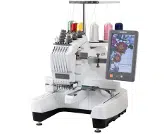Loading ...
Loading ...
Loading ...

148
The thread tension is incorrect.
The upper thread is not threaded correctly. 77
The bobbin thread is not correctly threaded. 36
The bobbin thread tension is incorrect. 102
Lint or dust has accumulated in the thread
tension disc.
140
The upper thread comes out of the needle when
embroidering begins.
If a short length of thread remains after the thread
is trimmed, the needle may become unthreaded
when embroidering begins again.
• Set the remaining length of thread to [Long Tail]
on settings screen.
110
The upper thread does not reach the bobbin thread
when embroidering begins.
There is no more thread in the bobbin, the thread
does not feed from the bobbin, or the thread that
is fed from the bobbin is too short.
• Correctly thread the bobbin thread.
36
Although the thread is not broken, a broken thread
error occurs and the machine stops.
If the thread breakage sensor in the thread
tension disc of the thread tension knobs cannot
detect that the thread is being fed, even if the
machine is running, a broken thread error occurs
and the machine is stopped.
• Correctly pass the thread through the thread
tension disc. If the broken thread error occurs
after the machine is rethreaded, the sensor
may be damaged.
140
*
The thread is worn.
Lint or dust has accumulated in the thread
tension disc.
140
Jump stitches are long.
Lint or dust has accumulated in the thread
tension disc.
140
Long jump stitches have been specified. 109
There are needle cuts or holes in the garment.
The needle is dull.
• Replace the needle. Dull needles have a
difficult time passing through the garment,
causing fabrics to tear.
140
The fabric is too delicate.
• The simple penetration of the needle could
damage delicate fabrics. Use stabilizer on top
of fabric.
—
Symptom
Probable Cause/Remedy Page
Fabric is puckering.
The thread tension is too tight.
• Adjust the tension according to the type of
fabric and thread being used. Polyester thread
will stretch during embroidery especially if the
tensions are set too high. After the stitching is
complete, the thread returns to its original
strength, causing puckers in the fabric.
104
The framing tension of the fabric is incorrect.
• Tightly frame non-stretchable, woven fabrics.
Loose framing will cause the fabric to bunch up
under the stitching. Tautly frame soft knits
using a stable backing. Overstretching the
garment will cause it to look puckered when
the frame is removed.
—
The column stitches are too long.
• Re-digitize the design with fill stitching or with
multiple rows of column stitching.
—
The needle is dull.
• Dull needles push fabric down and damage
material. Replace the needle.
140
The design density is too heavy.
• Too many stitches in an area pull fabric,
causing it to pucker. Slightly decrease the
design density by 5% to 10%.
110
The LCD cannot be read.
The LDC screen is too bright or too dark.
• Adjust the brightness of the screen display.
—
When embroidering thick fabric, the fabric cannot be
correctly hooped.
Fabric slips within the frame because of its
thickness.
• Wrap masking tape or bias tape around the
outer frame. The tape will provide resistance so
that the fabric does not easily slip.
—
The embroidery crosshair positioning laser is hard to
see.
The embroidery crosshair positioning laser is too
bright or too dim.
• Adjust the brightness of the embroidery
crosshair positioning laser.
74
I forgot my administrator lock passcode.
• Check with the administrator who specified the
passcode.
• If the wrong passcode is entered 10 times, the
passcode will be reset. The initial passcode is
999999.
129
I forgot my operator lock passcode.
• Check with the administrator who specified the
passcode.
• If the wrong passcode is entered 10 times, the
passcode will be reset. The initial passcode is
9999.
130
Symptom
Probable Cause/Remedy Page
Loading ...
Loading ...
Loading ...
